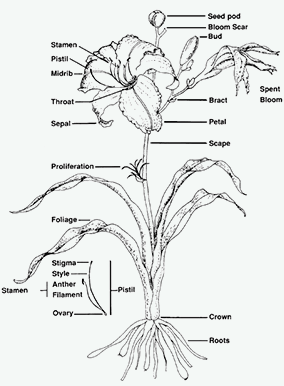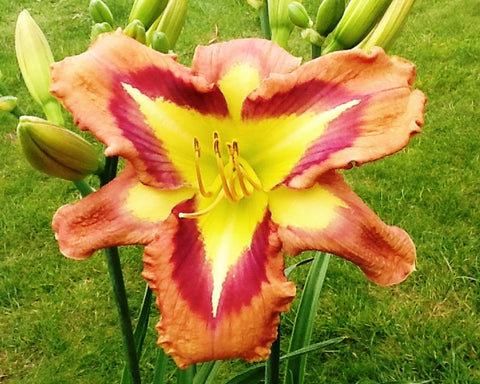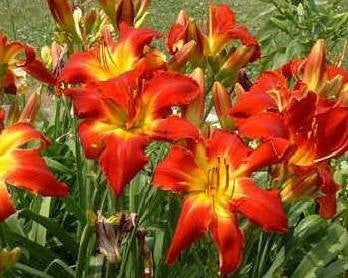Hemerocallis - Facts and Information

The Genus Hemerocallis is in the Subfamily Hemerocallidoicea, family Asphodelaceae in the order Asparagales and as such is NOT a lily. Such confusion from naming it a Daylily! Not a lily, not a bulb.
Hemerocallis (pronounced hem-er-o-kal-is) are rugged, adaptable, vigorous perennials that can endure in a garden for many years with little or no care once estabished. Hemerocallis adapt to a wide range of soil and light conditions; they establish quickly, and survive winters with little or no injury. Each hemerocallis bloom lasts one day but once established each plant produces an abundance of flower buds that open over a long period of time.

Although the origin of the hemerocallis is in China and the Far East, the home of the modern hemerocallis is the USA with varieties registered with the American Hemerocallis Society, the recognized worldwide authority. Hemerocallis sold in the UK have been hybridized in countries all over the world, particularly America, but the UK has some very promising work in hybridizing at present. Because they can be bred and grown in climates much different to ours it is important that they are proved in our climate and British grown before they are released for sale,

Hemerocallis are useful in the perennial flower border, planted in large masses, as ground cover on slopes, as single specimen clumps, or in pots and containers. There are many varieties of hemerocallis, with a wide range of flower shapes and colours and an array of bloom times that can continue from early spring on into late summer with ‘peak’ season occurring in July. Heights range from little mites of 8 inches to large towering scapes of 5 feet plus. Bloom sizes will vary from the ‘mini’s’ of under 3 inches to the ‘extra-large’ of more than 7 inches (see glossary). There are round shapes, spidery shapes, curling forms, doubles, ruffles, eyezones… with more than 90,000 registered varieties there is something for every garden and every gardener’s taste. Quite possibly the perfect plant: reliable, eye-catching and floriferous.
Although the hemerocallis is a very forgiving plant it does appreciate care and rewards the gardener with more prolific blooming. It enjoys full sun but 6 hours a day will be sufficient during bloom time. The hemerocallis is not fussy about soil pH but ideally likes to be in very slightly acidic conditions. It will do fine in sandy soils, clay and chalky soil but, like most plants, appreciates light humus-enriched soil. It is not a heavy feeder but enjoys a yearly application of compost or manure. It is very drought-tolerant (have I said yet that it’s hard to kill hemerocallis?) but again, blooms best with generous watering.

The hemerocallis is a garden plant that is an investment for the future. Hemerocallis plants grow initially as a single 'fan' of leaves coming from the 'crown'. Further fans appear once the plant is established, usually beginning during the first year. They are sold as 2,3,4 fans or more. These will grow into a clump and most likely outlive their owners. It is common to see abandoned old homesteads in the US with nothing left but an abundant supply of daylilies surrounding what used to be the home. Most hemerocallis varieties will bloom in their first year. Some are very fast 'clumpers' and some relatively slow but when too big they are easily divided (4-5 years).
Understanding the Daylily
The genus Hemerocallis belongs to the subfamily Hemerocallidoideae, family Asphodelaceae, in the order Asparagales. Despite the common name "daylily," it is important to remember that the hemerocallis is not a true lily and does not grow from a bulb. This confusion comes from its name, but botanically speaking, it is a very different plant.
Hemerocallis (pronounced hem-er-o-kal-is) are rugged, adaptable, and vigorous perennials. Once established, they can thrive for decades in a garden with very little care. They are known for their ability to adapt to a wide range of soils and light conditions, making them suitable for gardens across the UK. Each flower lasts for only one day, but the plants produce an abundance of buds that extend the flowering period for weeks.

Why You Can Trust Us
Strictly Daylilies is led by Paula Dyason, International Chair of the American Hemerocallis Society, with decades of hands-on experience. As one of the UK’s largest daylily nurseries, we combine expert breeding, RHS recognition, and proven growing success to provide healthy, reliable plants backed by a no-quibble guarantee.
Origins and Development of Hemerocallis
The origins of the hemerocallis lie in China and the Far East, where it was cultivated for centuries. However, the home of the modern hemerocallis is the United States. Most varieties registered today are catalogued by the American Hemerocallis Society (AHS), which is recognised as the global authority for these plants.
Hemerocallis cultivars available in the UK are often bred in America and other countries with different climates. For this reason, it is important that new varieties are tested and grown in British conditions before being widely released for sale. At Strictly Daylilies, every plant offered is proven in our climate, ensuring it performs reliably in UK gardens.
Why Gardeners Love Hemerocallis
Hemerocallis are versatile and reliable perennials. They can be planted in many ways:
- As part of a mixed flower border.
- In large drifts or masses for bold displays.
- As ground cover for slopes and banks.
- As single specimen clumps for impact.
- In pots or containers for smaller spaces.
Their diversity is extraordinary. With more than 90,000 registered varieties worldwide, gardeners can choose from a vast range of flower shapes, colours, and forms. Some bloom as early as May, while others extend into September, with July being the main peak.
Heights vary from tiny cultivars of just 8 inches to towering scapes over 5 feet tall. Flower sizes range from under 3 inches (miniatures) to more than 7 inches across (extra-large). Shapes include round blooms, spider types, curled petals, doubles, ruffles, picotee edges, and patterned forms with striking eyezones. This sheer variety makes the hemerocallis one of the most rewarding garden plants available.

The Parts of a Daylily Plant
Understanding the structure of a hemerocallis helps gardeners to grow and maintain them successfully. The plant is made up of several key parts:
- Crown – The central growing point at soil level from which roots and leaves emerge.
- Fans – Upright clusters of leaves that grow from the crown. A plant usually begins with a single fan but develops more as it matures.
- Roots – Fleshy roots that anchor the plant and store nutrients. Unlike bulbs, they are perennial structures that persist year after year.
- Scapes – The flower stalks that rise from the crown. Scapes carry the buds and blooms.
- Buds – Each scape produces multiple buds, which open in succession over several weeks.
- Flowers – The showpiece of the plant, each bloom lasting a single day but replaced by many others through the flowering season.
This growth habit makes the hemerocallis particularly long-lived. Plants naturally expand into clumps over time, often outlasting their gardeners.
Growth and Longevity
Hemerocallis are often described as “plants for life.” A single fan of leaves develops into multiple fans during the first season. Over the years, this expands into a clump that can remain in place for decades. Many abandoned homesteads in the United States still have thriving daylilies long after houses have disappeared.
Most hemerocallis varieties bloom in their first year, provided they are planted well. Some clump quickly, while others are slower. When clumps become too large, usually after four to five years, they can be divided easily to rejuvenate the plant and create new fans.
Hemerocallis Care and Cultivation
Light Requirements
Daylilies flower best in full sun. Around six hours of direct light per day is usually sufficient to encourage strong blooms. While they can tolerate partial shade, especially in hotter climates, reduced light may limit the number of flowers.
Soil Conditions
Hemerocallis are not fussy about soil pH and will grow in sandy, chalky, or clay soils. However, they thrive in slightly acidic soil with good drainage and organic content. Adding compost or well-rotted manure improves structure and fertility.
Feeding and Fertilisation
Daylilies are not heavy feeders, but they do appreciate a yearly application of organic matter such as compost. A balanced fertiliser can be applied in spring for stronger growth and more prolific flowering. Overfeeding with nitrogen should be avoided, as this may encourage leaves at the expense of flowers.
Watering
One of the strengths of the hemerocallis is its drought tolerance. Plants will survive prolonged dry spells, but for best results, especially during flowering, generous watering is recommended. Keeping the soil evenly moist during summer will produce more blooms and prolong the display.
Maintenance
Hemerocallis are very low-maintenance plants. Spent blooms naturally shrivel and fall, but deadheading can improve appearance. At the end of the season, old foliage can be cut back to tidy the clump. Division is the main task needed every few years to prevent overcrowding.
The Beauty of Seasonal Bloom
Each hemerocallis flower lasts for only one day, opening in the morning and fading by night. This trait is reflected in the name, which derives from the Greek words hemera (day) and kallos (beauty). Yet the short life of each bloom is more than compensated for by the number of buds produced. A single mature clump can flower for many weeks, often producing hundreds of blooms in one season.
The flowering period is extended by selecting varieties with different bloom times:
- Early – Starting in June.
- Early-Mid – Typically opening in July.
- Mid – Peaking in mid-July.
- Late-Mid – Beginning in August.
- Late – Continuing into September.
Some varieties are also re-bloomers, sending up additional scapes later in the season after the first flush of flowers.
Hemerocallis Around the World
Although the USA is now the centre of modern breeding, daylilies are still celebrated in their countries of origin. In China, the hemerocallis has been valued for centuries both as an ornamental plant and for its edible flower buds. The cultural significance of the plant highlights its versatility and enduring appeal.
In the UK, daylilies are becoming increasingly popular thanks to their adaptability, resilience, and extraordinary beauty. Hybridising programmes here are also beginning to contribute promising new cultivars suited to the British climate.
Why Hemerocallis is the Perfect Garden Plant
- Thrives in a wide range of soils and climates.
- Long-lived perennials that require little maintenance.
- Flowers over many weeks with spectacular colour.
- Available in an almost endless variety of forms and shades.
- Drought-tolerant yet rewarding when cared for.
- Equally at home in borders, containers, and naturalised plantings.
Whether you are a new gardener or an experienced collector, the hemerocallis has something to offer.
Conclusion – A Plant for Every Garden
The hemerocallis is one of the most forgiving, versatile, and rewarding plants available to gardeners. From its fascinating history to its modern diversity of colours and forms, it deserves a place in every outdoor space. With minimal care, a single fan becomes a clump that flowers for decades, rewarding the gardener each summer with a display of unique daily beauty.
Frequently Asked Questions
Is a hemerocallis a true lily?
No. Despite the common name “daylily,” hemerocallis plants are not true lilies. They belong to the Asphodelaceae family, not the lily family, and grow from crowns and roots rather than bulbs.
How long does each hemerocallis flower last?
Each flower lasts for one day, but plants produce many buds that open in succession, giving a display over several weeks.
What soil is best for hemerocallis?
They grow in almost any soil but prefer light, humus-rich, slightly acidic conditions. Compost or well-rotted manure helps to improve performance.
Do hemerocallis plants need a lot of care?
No. They are low-maintenance perennials. With occasional watering, feeding, and division every few years, they will thrive for decades.
Can hemerocallis be grown in pots?
Yes. Many varieties are well-suited to pots and containers, making them ideal for patios and small gardens. Ensure containers are watered and fed regularly during the summer.









